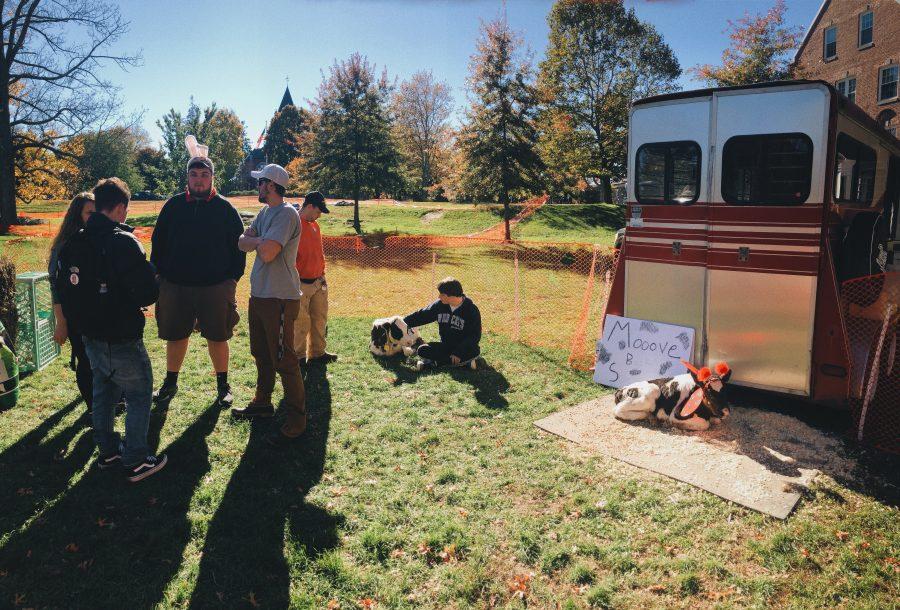
Unopened boxes of aluminum foil, toilet cleaner, Hannaford plastic bags and many other misfit grocery items were categorized from the dumpster waste found on Friday, April 22 near Parsons Hall, an academic building, and Alexander Hall, a residential building. President Mark Huddleston recognized that UNH’s waste and recycling practices are outdated, and recently established an initiative for zero waste on campus.
The event was advertised as a “Dumpster Dive,” but the organizers of the event used it to observe and categorize what is being thrown away as waste. Co-Chairmen of the initiative, Associate Vice President of the Office of Business Affairs, David May and Affiliate Professor of Forest Ecosystem Analysis John Aber, gathered a task force of four committees of procurement, recycling/bin containment, zero waste, and compost, paired with Huddleston’s support, to reduce waste and discover the waste practices of individuals on campus.
“I want us to get as close to zero waste as we possibly can,” Huddleston said. “We have a long way to go until we will be at where we want to be.”
Unopened wrapped books as well as uneaten yogurt, granola bars and clementines were fished out of the sea of waste on Friday.
Students interested in waste management and single-stream recycling attended to help categorize the waste for the experimental study conducted by Jennifer Andrews, the campus carbon calculator coordinator and Carbon Map coordinator.
“Others need to learn that just because we’re recycling, we need to be aware of what kind of plastic,” Andrews said. “It could be going right to the landfill, like paper towels and toilet paper.”
Sophomore environmental conservation and sustainability major Lauren Pitkanen found herself discovering glass object experiments, and expressed her passion for Earth Day. Pitkanen worked picking out the lids and straws of iced coffee cups, learning about what is thrown away in academic versus residential buildings.
Student Nick Ripczynsky, who serves as the environmental advocate for Hetzel Hall’s Council, assisted the categorization as well.
“The school promotes sustainability, but students aren’t doing their job,” Ripczynsky said.
Pia Marciano, a junior in the College of Engineering and Physical Sciences, said that there is a 60-80 percent diversion rate with what is recycled properly, and what is eventually identified as landfill.
Marciano, who has been involved in the sustainability program for three years now, said she believes that for proper waste management to be successful, there needs to be education in the investiture. For example, resident assistants (R.A.s) could educate their residents on how to properly dispose of waste.
“I was amazed people didn’t know what composting was until they got here,” Marcinao said.
Chris Kane is a non-profit advisor who worked with student senate and staff to come up with educational opportunities and solutions for data collection.
Kane felt that C-Lot was a particularly good location for the breakdown of waste because of the transparency involved in highlighting the differences in waste from a residence hall versus an academic building. According to Kane, most of what was thrown away could have been recycled.
According to Andrews, of the 66.43 pounds sampled, 21 percent (14.1 lbs) was actual trash, and 72 percent (47.63 lbs.) was material that should have gone into the recycling dumpster. She noted 51 percent (26 lbs.) was material that was appropriate for the landfill, 36 percent of the material (18.5 lbs.) was recyclable, and 13 percent (seven lbs.) was material that could have been composted if it were available in dorms.
Executive Director of Hospitality Services Bill McNamara said that he is now the chairman of the zero waste initiative for UNH’s athletic stadium construction. McNamara said that 90 percent of the issue with waste is landfill diversion, meaning that many items that could have been recycled are often distinguished as waste by the individual disposing of them.
McNamara said he hopes the waste practices of the stadium will become a model on a campus-wide scale. Pictures of proper waste disposal will be posted around the stadium, and training sessions will be held for students interested in learning about recycling processes.
McNamara said he wants to make the stadium waste-free by the first football game in September. He also plans to make announcements throughout the year regarding waste management tips and knowledge.
“People attending the games aren’t always willing to read, but if there are pictures, it’s quick and easy to understand,” McNamara said.

























